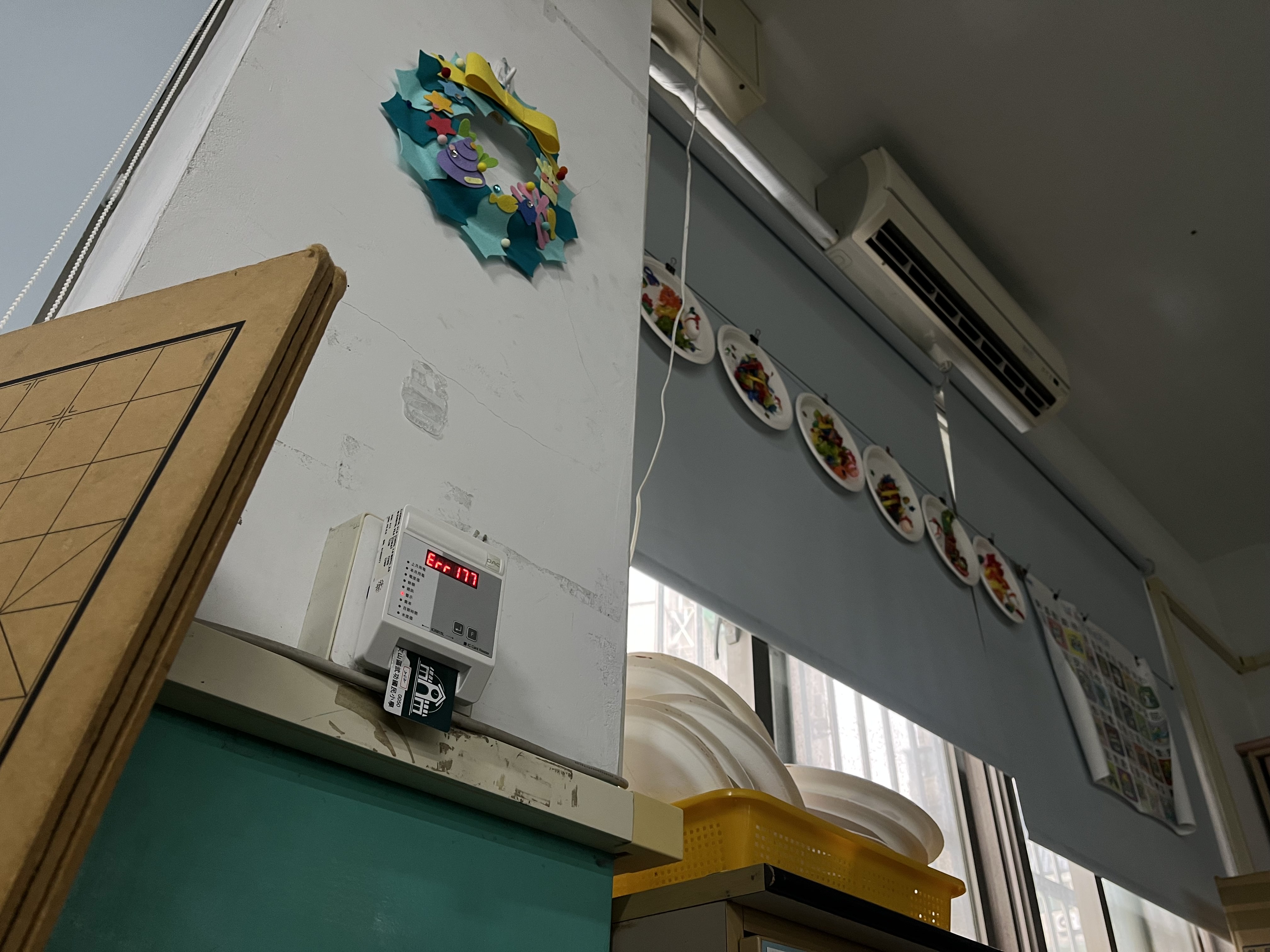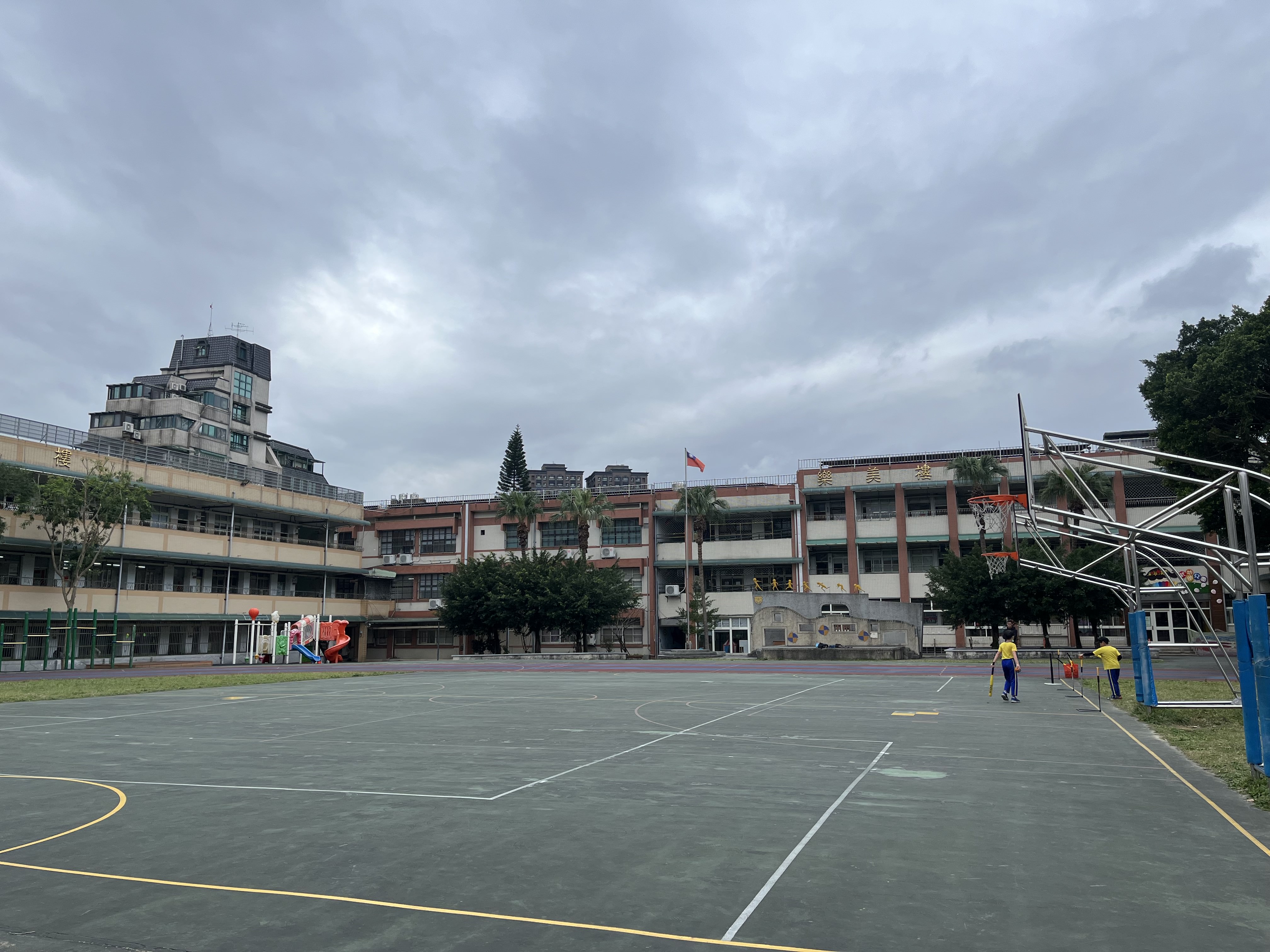隨著台灣的夏季越發炎熱,孕婦、兒童和老年人等弱勢族群正面臨高溫帶來的健康危機。科學家正在加緊研究高溫對脆弱族群的影響,並尋找有效的防範措施。

日益頻繁的熱浪和極端高溫事件,正在增加弱勢族群罹患熱相關疾病的風險。照片來源:Pixabay/ Moralis Tsai(CC BY 2.0)
過去30年,台灣的平均氣溫上升速度比全球來得更快。雖然開冷氣也能躲避高溫,但對於弱勢族群而言,高溫不僅令人不適,更可能危及生命。位處亞熱帶地區又橫跨北回歸線的台灣,弱勢族群罹患熱相關疾病的風險也進一步增加。隨著熱浪和極端高溫事件日益頻繁,「如何保護最容易受衝擊的族群」成為社會的迫切課題。
由台北醫學大學公共衛生學院院長陳怡樺帶領的研究團隊發現,懷孕後期暴露於高溫環境,可能會增加早產的風險。該研究使用2011~2022年間大台北地區的數據,結果顯示,高溫對於懷孕後期的母親及孩子的身心健康可能產生負面影響。對於在夏季出生的嬰兒,平均氣溫每上升1℃,媽媽的早產風險便增加6%。
雖然目前尚不清楚高溫如何誘發早產,但研究指出,脫水引起的血流變化以及壓力荷爾蒙(皮質醇)上升可能是潛在誘因。儘管研究已經確認高溫與早產之間的關聯性,但有效的預防策略仍在進一步探討中。陳怡樺建議,準媽媽可以儘早增加接觸綠地的機會,因為研究顯示這有助於降低高溫影響。
「天氣越熱,學生就越難安定下來。」台北市立武功國小導師黃冠淳表示:「如果還不能開冷氣,他們更容易情緒失控或變得暴躁。」
在武功國小,每間教室都配備了溫度感測器,當室溫達到28℃ 以上時,才可啟動空調。不過,學校會根據陽光對建築的影響做出調整。例如,太陽直射屋頂會使高樓層的溫度上升,頂樓的教室可以提前開啟空調。當空氣品質指標(AQI)達到紅色警戒,或戶外噪音過大時,學校也會開放使用空調。

武功國小教室內的溫度感測器與空調。溫度偵測還沒到達28℃,顯示器上只會顯示「錯誤」。 攝影:Jason Juang
兒童對熱壓力特別敏感,與成人相比,兒童的體溫上升速度更快,排汗量較少,在高溫或高濕環境下,更容易受到熱壓力影響。單純測量氣溫無法完整反映兒童實際感受到的熱壓力,因為陽光照射、濕度與風速等因素也會影響體感溫度。
為了更準確評估這些影響,科學家使用綜合溫度熱指數(Web Bulb Global Temperature, WBGT)來測量環境熱對人體的影響。綜合溫度熱指數能夠更準確地反映高溫的危險程度,成為衡量熱風險的重要指標。
一項針對台灣學校環境的研究發現,從2016~2022年,每年5~10月期間,有超過30%天數的WBGT值超過了熱危險門檻。台北、台中與嘉義的國中小學,WBGT值常常超過36℃。研究顯示,WBGT的峰值最常出現在上午10點至中午,甚至比一般溫度計的讀數更早達到高峰。因此,考量到兒童對熱壓力的脆弱性,戶外體育課或活動最好避免安排在危險時段,以免孩童暴露於高溫環境。
雖然政府尚未明文規定學校如何應對極端高溫,但許多學校已自行調整因應措施。「一般來說,體育老師會自行決定上課地點。如果天氣太熱,課程會改到體育館或地下室進行。」黃冠淳說道。
2020 年,台灣政府投入 23 億元,為全國3300多所國中小安裝超過18萬台空調,並升級電力系統,以提升校園耐熱能力。

武功國小的戶外操場。攝影:Jason Juang
由於調節體溫的能力下降,老年人面臨更高的高溫風險。在台灣,部分老年人可能會為了節省而不開冷氣,進一步增加中暑的風險。即使溫度尚未達到危害程度,對於家中缺乏適當空調設備的老年人來說,也可能構成健康威脅。
不過,目前有些方法可以幫助評估老年人的健康狀況。「一些社會福利,例如提供老年人每日補助午餐的計畫,高溫期間也可以兼具公共健康監測功能。」國立台灣大學環境與職業健康科學教授楊孝友表示,他的最新研究聚焦於全球暖化對弱勢族群造成的高溫危害,透過鼓勵老年人走出家門,社工可以藉機關心他們的身體狀況,並評估是否具有高溫相關的健康問題。
楊孝友舉例,弘道老人福利基金會的「餐食服務計畫」,每日提供弱勢長者午餐,這類社會計畫可以在熱浪期間發揮健康監測的作用。「這類健康評估計畫的潛力仍在評估中,」楊孝友表示,「目前台北已經有試辦計畫正在進行。」
楊孝友提出,應該推動由社區主導、政府資金支持的氣候政策,不僅能讓在地社群的聲音被聽見,還能透過政府資金調度,將資源送到原本難以觸及的地方。
 國立台灣大學公共衛生學院。攝影:Jason Juang
國立台灣大學公共衛生學院。攝影:Jason Juang
雖然大多數台灣人在有空調的建築內生活和工作,但弱勢族群仍需要額外的保護來抵禦極端高溫。專家建議,政府應進一步採取更積極的措施,例如建立高溫預警系統,以準確識別高溫熱點和高峰時段,從而減少高溫暴露時間。
儘管如此,提高大眾的意識依舊至關重要。「我們仍然會收到政府關於熱壓力的通知,比如多喝水、天氣太熱時待在室內,」黃冠淳表示,這反映了政策推動與個人行動並行,以適應日益暖化的必要性。
As Taiwan’s summers grow hotter, vulnerable populations—pregnant women, children, and the elderly—are exposed to serious health impacts of rising temperatures. Scientists are now racing to understand how rising heat affects vulnerable populations and what can be done to mitigate its impact.
 The heatwaves and rising temperature are raising the risk of heat-related illnesses among vulnerable groups. Photo: Moralis Tsai/ Pixabay (CC BY 2.0)
The heatwaves and rising temperature are raising the risk of heat-related illnesses among vulnerable groups. Photo: Moralis Tsai/ Pixabay (CC BY 2.0)
Over the last three decades, Taiwan’s average temperature has increased at a rate faster than the global temperature rate. While many people are able to escape the heat with air conditioning, but, for vulnerable groups, the rising heat is not just uncomfortable, it is dangerous. Taiwan’s tropical climate and location on the Tropic of Cancer trap heat, increasing the risk of heat-related illnesses for vulnerable populations. As heat waves and rising heat events become more frequent, Taiwan faces an urgent challenge: how can it protect those most at risk?
A recent research project led by Dean Yi-Hua Chen from Taipei Medical University studying pregnancy in Taiwan revealed that exposure to heat during the later stages of pregnancy can increase the risk of premature delivery. Using data from 2011 to 2022 in the Greater Taipei Area, the results show that higher temperatures in late pregnancy has a negative impact on the mother and her child’s physical and mental wellbeing. For babies born during the summer, every 1℃ rises in the average temperature increases the risk of preterm birth by 6%.
While it is not clear how heat triggers preterm birth, dehydration induced blood flow change and increased cortisol levels were cited as potential triggers. While research has established a link between heat and preterm birth, effective prevention strategies are still under study. To better safeguard pregnant women, Professor Yi-Hua Chen suggests expectant mothers, as early as possible in pregnancies, to increase their exposure to green spaces, which has been shown to decrease heat exposure.
“My students are more restless in hotter weather” says Teacher Kuan-Chun Huang (黃冠淳), a homeroom teacher at Taipei Municipal WuGong Elementary School (武功國小), “they’re more prone to outbursts or be more irritable, especially if the A/C can’t be turned on yet.”
For WuGong Elementary School, each classroom is equipped with an air temperature sensor that allows access to air conditioning once the ambient temperature has reached 28 ℃ or higher. Before 28 ℃, the display will only show an error message. Additionally, during the summer, WuGong Elementary School has adapted to how the sun affects their buildings. Classrooms on the highest floors are allowed to get air conditioning access earlier in the day due to the sun’s heating effect on the roof. Beyond heat, air conditioning is used when the air quality index is above the red warning level or when there are outdoor noise disturbances.
 The temperature sensor and A/C inside a classroom in WuGong Elementary School. Photograph: Jason Juang
The temperature sensor and A/C inside a classroom in WuGong Elementary School. Photograph: Jason Juang
For children, rising temperatures are more than just uncomfortable – they pose serious health rise. Their body temperature heats up faster, they sweat less than adults, and, in hot or humid weather, are more susceptible to heat stress. Standard temperature readings don’t fully capture the heat stress that children fully experience with factors like sunlight, humidity, and wind speed also playing a role.
To account for these factors, scientists use Wet Bulb Global Temperature (WBGT), a measurement of environment heat as it affects humans. Unlike a simple temperature reading, WBGT reflects how danger the heat is, making it an important metric for determining heat risk.
A study on Taiwanese school environments found that from 2016-2022, more than 30% of the days between May and October exceeded WGBT’s heat danger threshold. For middle and elementary schools in Taipei, Taichung, and Chiayi, they often exceeded 36℃. The study revealed that the WBGT peaks before a thermometer does at 10am to noon, and, with children being a particularly vulnerable group to heat stress, scheduling outdoor physical activities/ classes can be restructured to prevent exposure to dangerous levels of heat.
While not dictated by the government, schools have adapted to extreme heat on their own. “Generally, the PE teacher will make arrangements themselves for indoor or outdoor classes. If it’s hot, they will have classes in the gymnasium or in the basement floor.” Says Teacher Huang.
In 2020, the Taiwanese government invested NT$2.3 billion to install more than 180,000 air conditioning units and improve the electrical systems of more than 3,300 elementary and middle schools nationwide.

The outdoor field of WuGong Elementary School. Photograph: Jason Juang
Elderly people are at significantly higher risk because of a diminished ability to regulate temperature. Often, pre-existing health conditions such as the Three Highs also exacerbate issues. In Taiwan, social behaviors that are frequently used by the elderly, such as not turning on the AC to save money, can also increase heat risk. Even moderate heat can be dangerous for older adults if their homes lack proper air conditioning.
However, there are solutions to help assess the health of the elderly. “Social programs such as ones that provide daily subsidized lunch to the elderly have the potential to double as public health assessment programs during periods of hotter temperatures” says Dr. Hsiao-Yu Yang, a Professor of Environmental and Occupational Health Sciences at National Taiwan University. His latest research focuses on the heat hazards of global warming effect on vulnerable populations. Incentivizing the elderly to leave their home, social workers can ask if the elderly are doing well and assess if there are any immediate issues with heat.
Social programs such as Hondao Elderly Welfare Foundation’s “Hot Meal Program”, which provides daily subsidized lunch to disadvantaged seniors, could help monitor senior health during heat waves. “The potential of these [assessment] programs are still being evaluated” says Dr. Yang,“Pilot programs are still ongoing throughout Taipei.”
Dr. Yang proposes climate policies that are community-driven initiatives supported by government funding, incorporating the voices of the people while also enabling government scale mobilization of funds to reach places that otherwise wouldn’t receive them.
 National Taiwan University School of Public Health. Photograph: Jason Juang
National Taiwan University School of Public Health. Photograph: Jason Juang
While many Taiwanese live and work in air-conditioned buildings, vulnerable populations need extra protection from extreme heat. Experts further recommend more proactive efforts including implementing a heat warning system to accurately identify hot spots and peak heat hours to decrease exposure time to heat.
Despite these efforts, awareness still remains vital. “We still all receive government notices for heat stress. Drink more water and stay inside when the weather is too hot” says Teacher Huang, reflecting the need for policy based and individual actions to adapt to a warming climate.
最近一個月的網頁瀏覽次數:131888